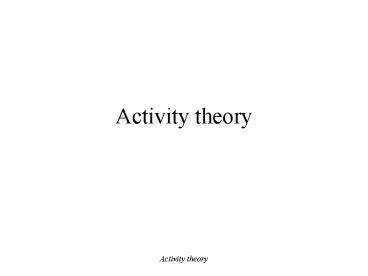Outline PowerPoint PPT Presentation
1 / 19
Title: Outline
1
Activity theory
2
Outline
- Introduction
- Philosophical background
- Evolution of Activity theory
- from Vygotsky to Engeström
- Main concepts and principles
- Implications for human computer interaction
3
Introduction
- The theory evolved from the work of Vygotsky
(1896-1934) - Vygotsky is the founder of the historical-genetic
method - He was contemporary of Pavlov, the father of
reflexology and then behaviorism - Vygotsky criticized the mentalist tradition
- Individual consciousness is built from the
outside through relations with others it must be
viewed as products of mediated activity
4
Philosophical background
- Influenced by the Theory of dialectic
materialism developed by Marx and Engels - For Marx and Engels, labor is the basic form of
human activity Their analysis stresses that in
carrying out labor activity, humans do not simply
transform nature they themselves are also
transformed in the process The tools that are
available at a particular stage in history
reflect the level of labor activity. New types of
instruments are needed to carry out the
continually evolving new forms of labor activity
(Wertsch, 1981p. 134-135)
5
Philosophical background
- Vygotsky appropriated ideas about how tools or
instruments mediate the labor activity and
extended those ideas to include how psychological
tools mediate thought - He plays with the similarity between Marxs
notion of how the tool mediates human labor
activity and the semiotic notion of how sign
systems mediate human social processes and
thinking - His point is that instruments are not only used
by humans to change the world but also they
transform and regulate humans in this process
6
Vygotskys statements
- Psychological tools language, writing, maps
etc.- are artificial formations. By their nature
they are social - They are directed toward the control of
behavioral processes just a technical means are
directed toward the control of processes of
nature - Emphasis on the mediation by psychological tools
in the study of thinking and consciousness
7
Vygotskys critique of the elementary form of
behavior
- S
X psychological tool
R
initial formulation of an instrumental act
8
The basic structure of activity
- The object is held by the subject and motivates
the activity giving it a specific direction - The mediation can occur through the use of many
different types of tools, material tools as well
as mental tools
9
Hierarchical structure of activity
- From individuals to collective activities
(Leontiev, 1930s), emphasizing the role of other
human beings and social relations in the
triangular model of action - Leontievs model
- Activity ----------------?motives
- Action------------------? goal
- Operation ---------------? conditions
10
The structure of human activity (Engeström
1987)
11
The general structure of the animal form of
activity (Engeström, 1987)
12
Mediation between subject and community
The relation between the subject and the
community is regulated/mediated by rules
13
Mediation between community and object
The relation between the community and the object
is regulated/mediated by a division of labor
14
The structure of human activity (Engeström
1987)
15
Main concepts
- Subject the individual/subgroup chosen as the
point of view in the analysis. - Tools physical or psychological.
- Community individuals/subgroups who share the
same general object. - Division of labor division of tasks between
members of the community. - Rules explicit/implicit regulations, norms,
conventions that constrains action/interaction - Object the raw material or problem space at
which the activity is directed and which is
molded or transformed into outcomes
16
Contradictions, tensions, conflicts, breakdowns
17
Contradictions, tensions, conflicts, breakdowns
- Indicators of problems within activity systems
- However, only when problems make themselves known
that are they possible to treat - Only by innovative solutions to surfacing
systematic problems can an activity develop
18
Main principles (cf.Kaptelinin, 1996)
- The unity of consciousness and activity
- Object-orientedness (not to be confused with
object-oriented programming) - Hierarchical structure of the activity
- Internalization/externalization
- Mediation
- Development
19
Implications for human computer interaction
- Human
- Users are actors having intentions/motivations/nee
ds - Interaction
- There is a psychological relation between the
user and the tool, - Computer
- A technical system does not immediately
constitute a tool for the user. Even explicitly
constructed as a tool, it is not, as such, a tool
for the user, - A technical system only becomes a tool through
the users activity, - A tool is never given, the user contributes to
its design, - A tool in use is not the object of the users
activity, - Tools can have real and important impacts on
human activity

